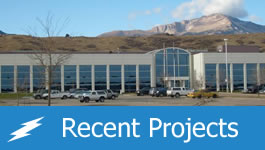Originally invented in 1859, lead-acid batteries today power vehicles and provide backup power for automakers, air traffic control towers, hospitals, financial centers, government sectors, and other large businesses. Classified as Hazardous Material by the U.S. Environmental Protection Agency, lead-acid and nickel-cadmium batteries require proper disposal. Fortunately, the typical flooded battery is 99% recyclable.
Batteries account for more than 80 percent of today’s lead consumption. With lead recycling rates surpassing 95 percent (according to the Association of Battery Recyclers), lead-acid batteries are the most recycled consumer product on the planet.
Applied Power Services will palletize and transport your spent batteries to one of our approved reclamation facilities. Our packaging and labeling will be in compliance with the U.S. Department of Transportation – Code of Federal Regulations (CFR). In addition, all disposals will be in accordance with federal, state & local regulations. If requested, we can provide you with a Death Certificate or Certificate of Recycling.
We use several companies in the recycling process including The Doe Run Company which operates one of the world’s largest single-site lead recycling facilities in the world.
Wet Cell Battery Packaging – Lead Acid, Nickel Cadmium, Nickel Metal Hydride, and Nickel Iron.
All battery jars will be carefully banded to strong and sturdy wooden pallets with 5/8″ steel or vinyl banding making certain that the banding DOES NOT come in contact with battery terminals. The battery terminals will be covered with duct tape and cardboard to protect the terminals. The top surface of the pallet will have wooden strips nailed to the pallet surrounding the base of the batteries to prevent the batteries from sliding off the pallet during transit. After the wooden strips, banding and cardboard is placed over the top of the terminals, stretch/shrink wrap will be used to go around the sides of the pallet for additional protection, making sure that the stretch wrap goes down around the base of the wooden pallet.
When shipping wet cell batteries containing a liquid electrolyte, you must place a “Corrosive 8” placard on opposite sides of each pallet and a DOT compliant Bill of Lading for each shipment.
Non-Spillable Lead Acid Types – Lead Acid VRLA & Lead Acid Steel Cased “Rack” Batteries
All battery terminals will be protected with cardboard and stretch wrap. Battery terminals will be heavily protected prior to transport. If we are shipping lead acid batteries that are still in steel racks, we will secure the racks to a heavy duty pallet, using sufficient banding to ensure the rack will not topple during transit.
If we are shipping VRLA, non-spillable Lead Acid, cells only (no steel racking), they will be placed on the pallet with the battery posts facing up. We will cover the battery terminals with duct tape in order to protect against a short circuit. The cells will be banded together using heavy gauge banding material and also have an ample amount of stretch-wrap wrapped around the cells to ensure the batteries stay together on the pallets if the banding material should fail. We make sure that the stretch wrap goes down around the base of the wooden pallet. We do not stack batteries on pallets higher than 36” or taller than the width of pallet. When shipping Lead Acid, VRLA, non-spillable batteries, we place a “Non-Spillable Battery” label on opposite sides of each pallet or container, and a DOT compliant Bill of Lading for each shipment.


